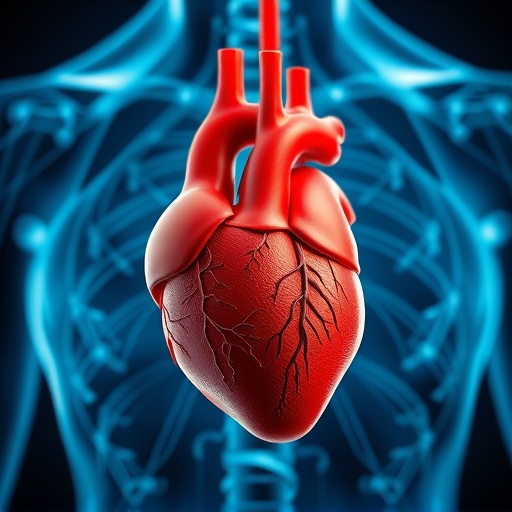In a groundbreaking advancement in cardiac medicine, researchers from ETH Zurich and the University Hospital of Zurich have unveiled a novel three-dimensional heart patch designed to address critical heart tissue damage following a heart attack. The patch, known as the “RCPatch” or Reinforced Cardiac Patch, is a significant leap forward from the conventional bovine pericardial patches used in heart repair. This revolutionary development, published in the esteemed journal Advanced Materials, aims to not only seal heart defects but also facilitate the healing process.
Heart attacks cause interruptions to the essential blood flow, leading to severe oxygen deprivation that harms heart tissue. In extreme cases, this can result in heart wall rupture, necessitating urgent surgical procedures. Traditionally, heart defects have been patched using bovine pericardial patches, known for their stability and ease of use. However, these patches also have downfalls; they are biologically inert and remain in the body indefinitely as foreign materials, which can trigger adverse reactions such as inflammation or calcification.
The interdisciplinary group, led by Professors Robert Katzschmann and Omer Dzemali, set out to create a heart patch that would integrate seamlessly into the heart’s biological framework rather than simply serving as a foreign object. The RCPatch is designed to bolster the heart’s healing processes by incorporating living cells and biodegradable materials, thereby addressing some of the critical limitations of current interventions.
One of the RCPatch’s most significant features is its unique composition. Unlike traditional patches, it comprises three essential components: a delicate mesh that serves as a sealing agent, a robust 3D-printed scaffold that provides stability, and a hydrogel infused with living heart muscle cells. This intricate design allows the patch to not only close the wound but also promote tissue integration. The scaffold’s lattice structure is made from a degradable polymer, which supports cell growth while being reabsorbed by the body over time, leaving no foreign material behind.
The collaboration of the ETH researchers has resulted in a strong foundation for a new generation of heart patches. By combining the mesh and the scaffold with a hydrogel, the RCPatch is engineered to adhere delicately to the heart while fostering biological integration. The hydrogel contains live cells that can proliferate and develop connective tissues, facilitating healing and repairing the damaged heart muscle.
In initial tests conducted on animal models, researchers successfully implanted the RCPatch while demonstrating its ability to withstand the high-pressure conditions of the heart. These preclinical trials involved closing artificially created defects in the left ventricle of pigs, where the patch maintained structural integrity under conditions mimicking real heart pressure. As a result, the researchers were able to prevent bleeding and help restore cardiac function, indicating the patch’s potential effectiveness in real-world clinical applications.
The RCPatch’s design not only addresses the mechanical support required for successful implantation but is also tailored to promote biological compatibility and tissue regeneration. Unlike Bovine Pericardial Patches, which can lead to long-term complications due to their inert nature, this innovative patch is envisioned to assist in the complete regeneration of heart tissue. In addition to repairing functional defects, the RCPatch aims to ultimately rejuvenate myocardial tissue, offering hope for more effective heart attack treatments.
As the research progresses, the team plans to conduct further studies to refine the biomaterial properties of the patch and assess its performance over longer durations in animal models. By gathering more data on its durability and regenerative capabilities, they hope to pave the way for this technology to be safely utilized in human patients in the near future.
This pioneering work showcases the fusion of engineering, medicine, and biology in the quest to combat cardiovascular diseases, a major global health challenge. The potential of integrating living cells into heart surgery strategies heralds a future where heart attack survivors may not only recover better but may also experience a revitalization of their heart function.
With the RCPatch on the horizon, a new chapter in cardiac care is being written—one that holds the promise of healing hearts from within by utilizing the body’s innate regenerative capabilities. As this research progresses, the hope is that it will lead to innovative products that bring about substantial improvements in post-heart attack recovery and overall cardiovascular health.
Subject of Research: Development of the RCPatch for Heart Repair
Article Title: Volumetric 3D Printing and Melt-Electrowriting to Fabricate Implantable Reinforced Cardiac Tissue Patches
News Publication Date: 5-Aug-2025
Web References: 10.1002/adma.202504765
References: Lewis S. Jones et al. Volumetric 3D Printing and Melt-Electrowriting to Fabricate Implantable Reinforced Cardiac Tissue Patches, Advanced Materials. DOI: 10.1002/adma.202504765
Image Credits: Soft Robotics Laboratory / ETH Zurich
Keywords
Reinforced Cardiac Patch, Heart Tissue Repair, 3D Printing, Bovine Pericardial Patches, Biodegradable Materials, Hydrogel, Tissue Engineering.




